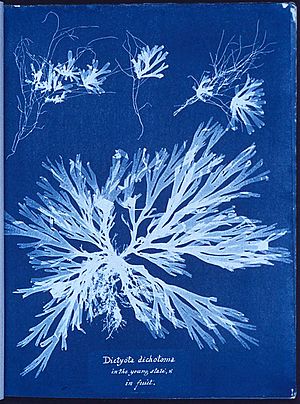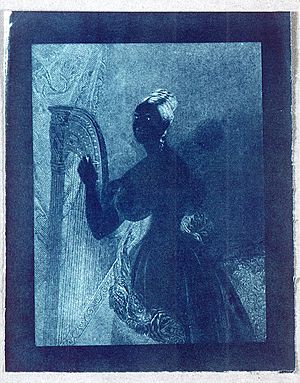Cyanotype facts for kids
Cyanotype is a special way to make photographic prints that are always blue. It's like magic, but it's science! A scientist named John Herschel found out how to do this in 1842. For a long time, even into the 1900s, engineers used this simple and cheap method to make copies of their drawings. These copies were called blueprints because they were blue! The cyanotype process uses two main chemicals: ammonium iron(III) citrate and potassium ferricyanide.
Contents
What is Cyanotype?
Cyanotype is one of the oldest ways to make photos. It doesn't need a darkroom or fancy equipment like modern photography. Instead, it uses sunlight or UV light to create images. The special chemicals react to the light, turning parts of the paper blue. Where the light doesn't hit, the paper stays white. This creates a unique blue and white picture.
How Does it Work?
Making a cyanotype print is quite simple. First, you mix the two chemicals, ammonium iron(III) citrate and potassium ferricyanide, with water. Then, you brush this liquid onto paper or fabric. Once the paper is dry, it becomes sensitive to light.
Next, you place objects or a photo negative on the coated paper. You can use leaves, feathers, lace, or even your own hands! Then, you expose the paper to sunlight. The parts of the paper that get light turn blue. The parts covered by your objects stay white. After a few minutes, you rinse the paper with water. This washing step makes the blue color permanent and washes away the unexposed chemicals. The result is a beautiful blue and white image!
History of Cyanotype
Sir John Herschel, a famous British scientist, discovered the cyanotype process in 1842. He was a brilliant astronomer and chemist. He found that certain iron compounds would turn blue when exposed to light.
Early Uses and Blueprints
One of the first people to use cyanotype for art was Anna Atkins. She was a British botanist, which means she studied plants. In 1843, she published a book called Photographs of British Algae: Cyanotype Impressions. This was the very first book ever to be illustrated with photographic images! She used cyanotypes to make detailed blue pictures of different types of algae.
For many years, engineers and architects used cyanotype to make blueprints. These were copies of their plans and drawings. It was a fast and cheap way to share designs. Imagine trying to draw every copy by hand! Cyanotype made it much easier.
Cyanotype Today
Even though we have digital cameras and printers now, cyanotype is still popular. Artists, photographers, and hobbyists love it for its unique look and hands-on process. It's a fun way to experiment with photography and create beautiful, one-of-a-kind blue artworks. You can make cyanotypes on paper, fabric, wood, and even glass!
Images for kids
-
An architectural drawing blueprint from Canada, 1936
-
A self-portrait of Linley Sambourne from 1895, posing for a Punch cartoon.
See also
 In Spanish: Cianotipia para niños
In Spanish: Cianotipia para niños











